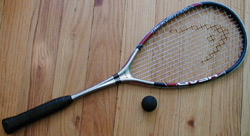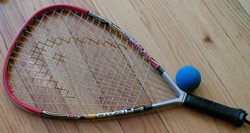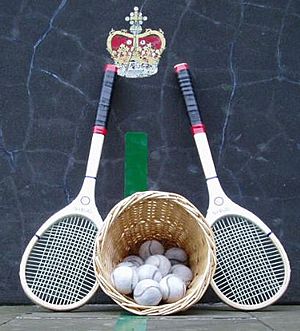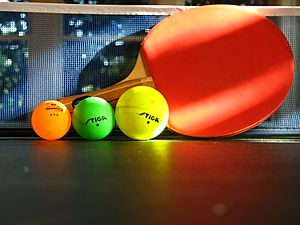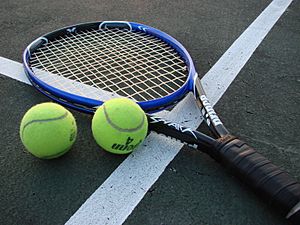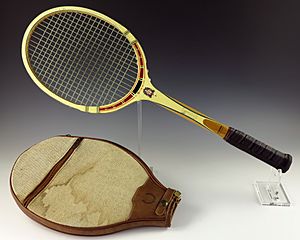Racquet facts for kids
A racket is a special tool used in sports. It has a handle and a frame with strings stretched tightly across it. People use rackets to hit a ball or a shuttlecock in games. Some popular racket sports include squash, tennis, racquetball, and badminton. All these games are known as racket sports.
Long ago, rackets were made from wood and strings from animal parts called catgut. The size of these old rackets was limited by how strong the wood was. Later, manufacturers started adding other materials to make them stronger. These new materials included steel, aluminum, and then carbon fiber.
Today, most rackets are made from modern materials. These include carbon fiber or fiberglass. Some also use metals like titanium or ceramics. The strings are often made from man-made materials like nylon instead of catgut. Professional players might restring their rackets after every game.
Contents
What is the Difference Between Racket and Racquet?
The word racket is the most common way to spell it. However, racquet is another spelling often used in some sports. These sports include squash, racquetball, and badminton. In tennis, racket is the preferred spelling. Even though racquet looks more French, racket is actually the older spelling. It has been used since the 1500s. Racquet only appeared later in the 1800s.
Where Did the Word "Racket" Come From?
The exact origin of the word "racket" is not fully known. Some people thought it came from an Arabic phrase meaning "palm of hand." But newer studies suggest it likely came from a Flemish word, "raketsen." This word itself came from an old French word, "rachasser," which meant "to strike the ball back."
Badminton Rackets
Badminton rackets are very light. Top-quality rackets weigh only about 80 to 100 grams, which is like a small apple. Modern badminton rackets are made from a material called carbon fiber composite. This material is strong but light. It also helps transfer energy well when you hit the shuttlecock. Before carbon fiber, rackets were made of wood. But wood rackets were too heavy and expensive.
There are many different designs for badminton rackets. However, their size and shape must follow the rules of the game. Some rackets have a traditional square head. But many new rackets have an "isometric" head shape, which is more common now.
Rackets for the Sport of Rackets
The sport called rackets is an older game. It is like an early version of squash. The rackets used in this game are made of wood and are about 30+1⁄2-inch (770 mm) long. Even though squash equipment has changed a lot, the equipment for the sport of rackets has stayed mostly the same.
Racquetball Rackets
For racquetball, there are no rules about how much a racket can weigh.
- The racket, including its bumper and handle, cannot be longer than 22 inches (about 56 cm).
- The racket frame can be made of any safe material.
- The racket must have a cord that is tied securely to the player's wrist.
- The strings must be made of gut, nylon, graphite, or other materials. They must not mark the ball.
- Using a racket that doesn't follow these rules means you lose the game.
Racquetball rackets often have almost no neck. The handle connects directly to the head. Their heads are usually wider at the top. Some older rackets even looked like triangles or teardrops.
Real Tennis Rackets
In real tennis, the rackets are about 27 inches (686 mm) long. They are made of wood and have very tight strings. This helps them handle the game's heavy balls. The heads of these rackets are bent a little. This makes it easier to hit balls close to the floor or in corners.
Squash Rackets
Standard squash rackets must follow the game's rules. They used to be made of wood, with a small area for strings made from natural gut. But after a rule change in the mid-1980s, they are now mostly made of strong materials. These include carbon fiber or metals like graphite, Kevlar, titanium, or boron. They use synthetic strings. Modern squash rackets are about 70 cm long. Their strung area can be up to 500 square centimeters. They usually weigh between 90 and 200 grams.
Table Tennis Rackets
Table tennis uses a special table tennis racket. It is made from layers of wood covered with rubber on one or both sides. Unlike other rackets, it does not have strings stretched across an open frame. This tool is called a "paddle" in the USA. In Europe, it's called a "bat." The official name from the ITTF is "racket."
Tennis Rackets
A tennis racket has several parts: the head, rim, face, neck, handle, and strings.
Modern tennis rackets come in different lengths, weights, and head sizes. Rackets for kids are usually 21 to 26 inches (53 to 66 cm) long. Adult rackets are typically 27 and 27.5 inches (69 and 70 cm) long. Some are even longer, up to 29 inches (74 cm). Racket weights can range from about 8 ounces (unstrung) to 12.5 ounces (strung).
The head size of a racket also matters. A larger head usually gives more power. It also has a bigger "sweet spot," which means it's easier to hit the ball well. A smaller head size gives more control over the ball. Today, racket head sizes range from 85–137 square inches (550–880 cm2). Most players use rackets with a head size between 95–105 square inches (610–680 cm2).
Some players add small rubber pieces called "vibration dampers" to their strings. These help make the racket feel better when hitting the ball.
For most of tennis history, rackets were made of layered wood. Their heads were about 65 square inches (420 cm2). In the late 1960s, Wilson made a steel racket. It became popular with player Jimmy Connors. In 1968, Spalding made an aluminum racket. Aluminum was lighter than steel but less accurate. So, many top players still preferred wooden rackets for a long time.
By 1975, aluminum rackets got better. This led to the first "oversized" racket. Prince made oversized rackets popular. They had a head size of about 110 square inches (710 cm2). This opened the door for other new head sizes, like mid-size (90 square inches) and mid-plus size (95 square inches).
In the early 1980s, rackets made of "graphite" (carbon fiber) materials were introduced. Other materials like ceramics, glass-fiber, and titanium were added too. The Dunlop Max200G, used by John McEnroe, was an early graphite racket. Composite rackets are the standard today. The last wooden racket was seen at Wimbledon in 1987.
Longer rackets were made by Dunlop. They help players reach further for shots like serves and volleys. Mid-size or mid-plus rackets are generally used by professional players.
How a tennis racket is strung is very important for how it performs. A few top players use natural gut strings. But most strings are made of nylon or polyester. Natural strings are thought to give a better "feel." However, synthetic strings last much longer, are more consistent, and cost less.
The string pattern (how the vertical and horizontal strings are woven) depends on the racket's head size and design. A tighter string pattern gives more control. A more "open" pattern can give more power and spin. Modern rackets have a recommended string tension range. Lower tension usually creates more power. Higher tension gives more control.
See also
 In Spanish: Raqueta para niños
In Spanish: Raqueta para niños


